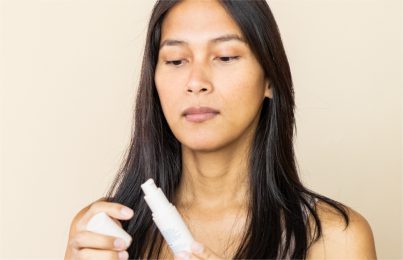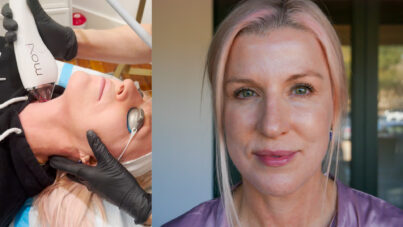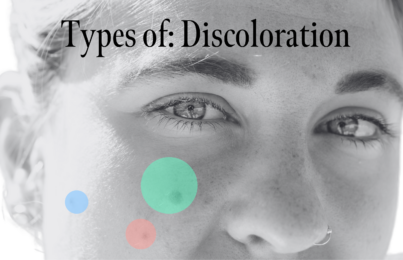Updated 6/24/20. Almost everyone has experienced a sunburn at one point or another. Symptoms of sunburn can include any combination of the following: skin that feels hot, tight, painful, sensitive, or itchy. For those with lighter skin tones, these symptoms can be accompanied by pink or red skin but if you have a deeper skin tone, you may not notice any redness at all. However, any skin tone can experience peeling after a few days of getting sunburned
While no one intentionally tries to get sunburned, the sun is strong and skin damage can sneak up quickly. Here’s my expert advice on how to soothe a sunburn and minimize the damage it can cause—and how to prevent it from happening again.
Why Do Sunburns Occur?
Let’s start by talking about the biggest reasons sunburns occur to begin with.
Not Wearing Sunscreen
People think when it’s an overcast day, they are not at risk for potential sunburn. False! UVB rays, which also burn your skin and can cause skin cancer, can penetrate through clouds and still put you risk. Also, when temperatures are fairly cool (such as on a fall day), people think the sun isn’t strong and that sunscreen is not necessary. Wrong again. The temperature outside is never an indication of how strong or weak the sun’s rays are.
While it’s always super important to wear sunscreen before you spend time outside, this should actually be your first defense against sun damage.
Not Applying Enough Sunscreen
Most people don’t apply their sunscreen generously enough to get full protection. You’ve got to really load it on in order for it to do its job. Otherwise, you’ll never get the amount of SPF indicated on the label, and certain areas of your skin will be at risk for burning. This occurs most often with spray sunscreens because you can’t control the application in the same way you can when applying a lotion or cream.
Trusting That a High SPF Number Will Keep You Protected
Did you know that an SPF 30 offers only four percent more sun protection than an SPF 15? And that an SPF 45 offers only two percent more than an SPF 30? The higher up you go, the more that percentage decreases. So while this may come as a surprise to many of you, it’s important to know that a high SPF number can give you a false sense of protection. It’s a lot more important that you apply your sunscreen properly, meaning that you use enough of it.
Not Reapplying Sunscreen Often Enough
Sunscreen wears off, sweats off, and washes off. If you’re spending time outdoors and/or are being active, you absolutely must apply it at least every ninety minutes.
What Can I Do If I Get Sunburned?
While avoiding a sunburn in the first place should be the goal, sometimes we’re having too much fun in the sun and forget ourselves. These things happen! And when they do, it’s time to go into repair mode. Here’s how to soothe a suburn and minimize the damage.
Drink Cold Water
Since your body loses fluids when it’s overheated, it’s important to drink ice water to keep the body’s temperature down and hydrate internally.
Soak in Milk
Soak in the tub with lukewarm or cool water mixed with six cups of whole milk. Why? First of all, a cool bath helps to lower the internal body temperature. Due to its fat and protein content as well as its pH, milk can have a soothing, anti-inflammatory effect. This will help take down redness and itching and will provide some comfort to tight, burned skin.
Apply a Cooling Gel Mask or Natural Aloe Vera Gel
The goal of treating a sunburn is to decrease pain and remove heat from within the skin. To do this, use a thick coat of a cooling, gel-based product on the body. You can use a gel masque formulated for the face. This can lower the skin’s temperature and deliver water to thirsty cells to alleviate the tight feeling and bring some relief.
Place any gel product in the refrigerator thirty minutes before use to increase its cooling benefits. Apply a gel mask or aloe vera gel to the skin, let dry for fifteen minutes, and rinse. Repeat every three hours. If you don’t have a gel masque on hand, try applying cold, plain yogurt.
A few quick thoughts about aloe vera gel. While aloe is a good healing ingredient, many aloe products contain synthetic dyes and fragrance. (Dyes are usually responsible for aloe’s bright green color you often see. Yuck! Natural aloe vera gel is a clear to slightly golden color). Artificial colorants, dyes, and drying alcohols may further irritate already sensitive skin, so ensure the aloe is both dye, alcohol, and fragrance-free.
After Rinsing Off a Mask, Apply a Lightweight Skin Oil With Antioxidants
Once you remove the gel, I recommend applying a treatment oil that contains antioxidants. Sunburn is the ultimate sign of free radical-induced inflammation and skin damage, and using topical antioxidants may help encourage repair within the skin. Types of oils to look for include pomegranate seed oil, cranberry oil and rosehip oil. Since the skin has essentially been “fried,” it can feel extremely stiff. With every move you make, the tight skin pulls and causes pain. An oil will lubricate the skin to lessen the tug and pull effect. Apply a few drops of a reparative, vitamin-packed skin oil post-mask to provide a variety of benefits, as well as some welcomed relief.
Don’t Over-Moisturize
Many people want to excessively apply lotion in an effort to heal the skin. But if you apply too much lotion, the heavy layers may create a barrier and actually trap heat in the skin, which will keep it red longer. I prefer using a very thin layer of skin oil instead of lotion. If you’re using lotion, be sure to use one that has a lighter consistency—not one that is too thick or greasy.
Be Patient and Allow Your Burn to Heal
For most mild to moderate sunburns, it takes three to four days for redness to subside. Do your best to keep it soothed and cool, but avoid messing with it too much. Your skin is great at repairing itself—let it do its job!
If the Skin Peels, Don’t Pick!
The natural healing process of a sunburn is for the skin to peel, starting a few days after a burn. The sunburn has already caused enough damage, so the worst thing you can do is start to peel off layers of skin—especially those that are not yet ready to come off. You can scar the skin by doing this, so just let the skin shed naturally.
After a week, you can gently rub the skin on the body lightly with a soft scrub or a loofah to help remove some of the surface flakiness. And most importantly, be careful when you get out of the shower because the dry cells are very soft and will rub off easily. You could risk also pulling off live tissue, which could result in oozing scabs. Be patient. Always work with Mother Nature and never go against her.
Don’t Make the Same Mistake Again
I can’t tell you how many times clients tell me, “I applied sunscreen and I still got burned. I even used an SPF 70!” Think about what you may have not done correctly the next time you’re outdoors. Always wear sunscreen, even if it’s an overcast day. Reapply a thick coat every two hours when spending a lot of time outside. Use clothing to cover exposed areas of skin. Skin is very vulnerable and needs to stay protected. Once you get sunburned, no amount of sunscreen can stop the burn from appearing. Get out of the sun right away!
Celebrity Esthetician & Skincare Expert
As an esthetician trained in cosmetic chemistry, Renée Rouleau has spent 35 years researching skin, educating her audience, and building an award-winning line of products. Her hands-on experience as an esthetician and trusted skin care expert has created a real-world solution — products that are formulated for nine different types of skin so your face will get exactly what it needs to look and feel its best. Trusted by celebrities, editors, bloggers, and skincare obsessives around the globe, her vast real-world knowledge and constant research are why Marie Claire calls her “the most passionate skin practitioner we know.”



